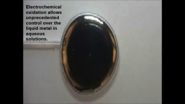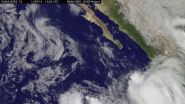(Press-News.org) Human skin and gut microbes influence processes from digestion to disease resistance. Despite the fact that tropical forests are the most biodiverse terrestrial ecosystems on the planet, more is known about belly-button bacteria than bacteria on trees in the tropics. Smithsonian scientists and colleagues working on Panama's Barro Colorado Island discovered that small leaf samples from a single tree were home to more than 400 different kinds of bacteria. The combined sample from 57 tree species contained more than 7,000 different kinds.
Bacteria in tropical forests may also play a vital role, protecting leaves against pathogens and even affecting the ability of forests to respond to climate change.
"Just as people are realizing that microbes carried by humans can have an influence on a person's health—positive or negative—we hope to discover what bacteria on tree leaves can tell us about the health of a forest," said S. Joseph Wright, a Smithsonian scientist and co-author of the new study published in Proceedings of the National Academy of Sciences.
In contrast to a previous study of bacteria on leaves in a temperate forest where different leaves had different bacteria, there was a core group of species of common bacteria present on leaves of nearly all of the species sampled in Panama. Just as on human skin, many of the bacteria on tropical tree leaves were Actinobacteria and Proteobacteria.
The researchers, from the Smithsonian Tropical Research Institute, University of Quebec, University of Arizona, University of Oregon, University of California—Los Angeles and Santa Fe Institute, also looked for relationships between the composition of bacterial communities on leaves and other plant characteristics.
Many bacteria were associated with certain functional traits such as leaf thickness, wood density or leaf nitrogen content, characteristics that directly impact tree growth, survival and reproduction.
The relationships between many of the bacteria and tree species they sampled were ancient, going back to the ancestors of both the bacteria and the trees as they evolved in tandem.
"Our ability to use molecular techniques like 16S ribosomal RNA gene sequencing to characterize nearly all of the bacteria on a leaf is going to make it possible to see how very different members of forest communities interact," said Wright. The Smithsonian forest ecologist and his colleagues hope to collaborate with researchers at the 60 Forest Global Earth Observatory sites coordinated by the Smithsonian's Center for Tropical Forest Science to compare interactions at different sites and under different environmental conditions.
INFORMATION:
The Smithsonian Tropical Research Institute, headquartered in Panama City, Panama, is a unit of the Smithsonian Institution. The Institute furthers the understanding of tropical nature and its importance to human welfare, trains students to conduct research in the tropics and promotes conservation by increasing public awareness of the beauty and importance of tropical ecosystems. Website: http://www.stri.si.edu.
Kembel, S.W., O'Connor, T.K., Arnold, H.K., Hubbell, S.P., Wright, S.J. and Green, J.L. 2014 Relationships between phyllosphere bacterial communities and plant functional traits in a neotropical forest. Proc. Nat. Acad. Sci. early online edition
http://www.pnas.org/cgi/doi/10.1073/pnas.1216057111
Smithsonian scientists discover tropical tree microbiome in Panama
2014-09-15
ELSE PRESS RELEASES FROM THIS DATE:
Scientists discover RNA modifications in some unexpected places
2014-09-15
CAMBRIDGE, Mass. (September 15, 2014) – The so-called central dogma of molecular biology—that DNA makes RNA which makes protein—has long provided a simplified explanation for how genetic information is deciphered and translated in living organisms.
In reality, of course, the process is vastly more complicated than the schema first articulated nearly 60 years ago by Nobel Laureate Francis Crick, co-discoverer of the DNA's double-helix structure. For one, there are multiple types of RNA, three of which—messenger RNA (mRNA), transfer RNA (tRNA), and ribosomal RNA (rRNA)—are ...
Study first to use brain scans to forecast early reading difficulties
2014-09-15
UC San Francisco researchers have used brain scans to predict how young children learn to read, giving clinicians a possible tool to spot children with dyslexia and other reading difficulties before they experience reading challenges.
In the United States, children usually learn to read for the first time in kindergarten and become proficient readers by third grade, according to the authors. In the study, researchers examined brain scans of 38 kindergarteners as they were learning to read formally at school and tracked their white matter development until third grade. ...
'Femme fatale' emerald ash borer decoy lures and kills males
2014-09-15
An international team of researchers has designed decoys that mimic female emerald ash borer beetles and successfully entice male emerald ash borers to land on them in an attempt to mate, only to be electrocuted and killed by high-voltage current.
"Our new decoy and electrocution process may be useful in managing what the U.S. Department of Agriculture Forest Service claims to be the most destructive forest pest ever seen in North America," said Michael Domingue, postdoctoral fellow in entomology, Penn State.
According to the Forest Service, the emerald ash borer was ...
Researchers control surface tension to manipulate liquid metals
2014-09-15
VIDEO:
Liquid metals have very large surface tensions that causes them to assume a spherical shape. Researchers have shown that the deposition of a surface oxide lowers the surface tension...
Click here for more information.
Researchers from North Carolina State University have developed a technique for controlling the surface tension of liquid metals by applying very low voltages, opening the door to a new generation of reconfigurable electronic circuits, antennas and other ...
Neuroscientists identify key role of language gene
2014-09-15
CAMBRIDGE, MA -- Neuroscientists have found that a gene mutation that arose more than half a million years ago may be key to humans' unique ability to produce and understand speech.
Researchers from MIT and several European universities have shown that the human version of a gene called Foxp2 makes it easier to transform new experiences into routine procedures. When they engineered mice to express humanized Foxp2, the mice learned to run a maze much more quickly than normal mice.
The findings suggest that Foxp2 may help humans with a key component of learning language ...
Network measures predict neuropsychological outcome after brain injury
2014-09-15
Cognitive neuroscience research has shown that certain brain regions are associated with specific cognitive abilities, such as language, naming, and decision-making.
How and where these specific abilities are integrated in the brain to support complex cognition is still under investigation. However, researchers at the University of Iowa and Washington University in St. Louis, Missouri, believe that several hub regions may be especially important for the brain to function as an integrated network.
In research published online Sept. 15 in the Early Edition of the Proceedings ...
Cells simply avoid chromosome confusion
2014-09-15
Reproductive cell division has evolved a simple, mechanical solution to avoid chromosome sorting errors, researchers report in the Sept. 11 Science Express.
This natural safeguard prevents incorrect chromosome counts and misalignments that lead to infertility, miscarriage, or congenital conditions.
"Mistakes during reproductive cell division cause these problems, but what exactly goes wrong is often not understood," said Adele Marston of the Wellcome Trust Center for Cell Biology at the University of Edinburgh in Scotland and lead author of the study. Understanding ...
NASA's TRMM satellite sees Hurricane Odile strike Baja California
2014-09-15
VIDEO:
This animation of NOAA's GOES-West satellite imagery from Sept. 13 through Sept. 15 shows Hurricane Odile's movement and landfall near Cabo San Lucas on Mexico's Baja California. TRT 0:42...
Click here for more information.
NASA's Tropical Rainfall Measuring Mission satellite known as TRMM captured data on powerful Hurricane Odile revealing heavy rainfall from powerful thunderstorms as it made landfall in Baja California. Odile tied a record for strongest hurricane to hit ...
IU study: Combining epilepsy drug, morphine can result in less pain, lower opioid doses
2014-09-15
INDIANAPOLIS -- Adding a common epilepsy drug to a morphine regimen can result in better pain control with fewer side effects. Moreover, the combination can reduce the dosage of the opioid needed to be effective, according to a team of pain researchers at Indiana University.
The result could bring significant relief to many patients with neuropathic pain, a difficult-to-treat condition often felt in the arms and legs and associated with nerve tissue damage.
"There is a huge unmet need for better treatments for neuropathic pain," said Fletcher A. White, Ph.D., the Vergil ...
'Squid skin' metamaterials project yields vivid color display
2014-09-15
The quest to create artificial "squid skin" -- camouflaging metamaterials that can "see" colors and automatically blend into the background -- is one step closer to reality, thanks to a breakthrough color-display technology unveiled this week by Rice University's Laboratory for Nanophotonics (LANP).
The new full-color display technology uses aluminum nanoparticles to create the vivid red, blue and green hues found in today's top-of-the-line LCD televisions and monitors. The technology is described in a new study that will be posted online this week in the Early Edition ...






